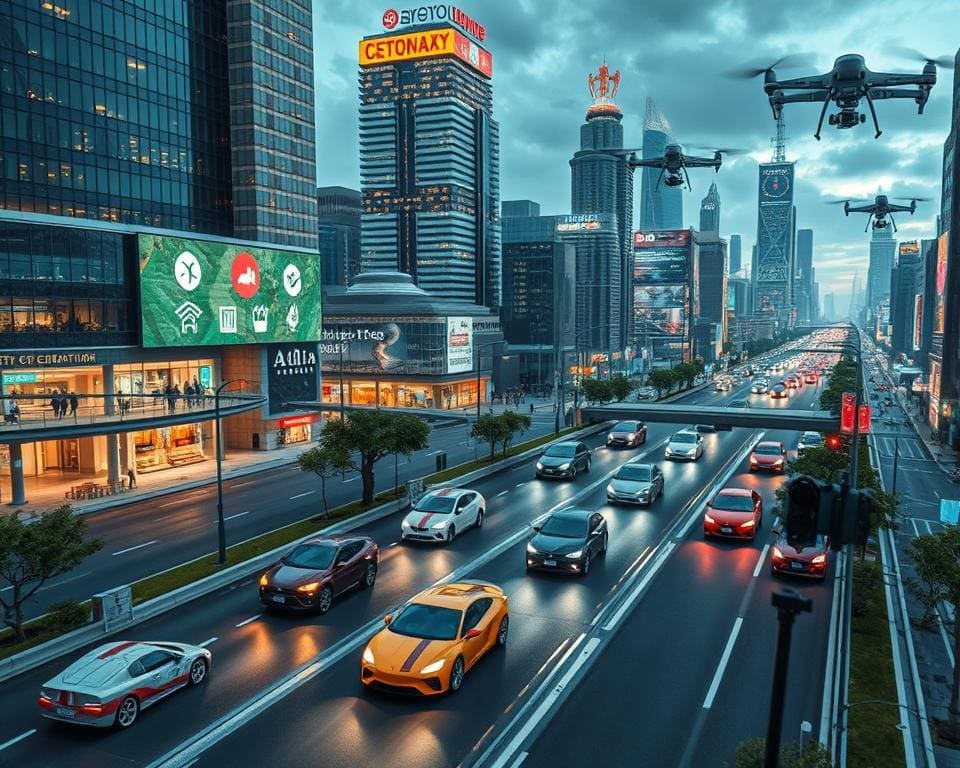In an era where digital connectivity in vehicles has become paramount, the emergence of vehicle-to-everything communication (V2X) represents a transformative leap in automotive technology. This innovative approach enables vehicles to interact seamlessly with each other and their environment, fostering enhanced safety and efficiency on the roads. As cars evolve into intelligent systems, the potential for smarter driving experiences becomes increasingly evident, reshaping how we navigate our journeys. Embracing the power of connectivity, the automotive industry is paving the way for a future where connectivity is not just an advantage, but an essential aspect of mobility.
The Evolution of Automotive Technology
The journey of automotive technology is a fascinating tale of innovation and transformation. From the invention of the first automobiles to today’s advanced smart cars, vehicle connectivity has evolved dramatically. Key milestones mark this journey, showcasing how cars have become sophisticated machines capable of interacting with their environment.
Historical Milestones in Vehicle Connectivity
Automotive technology witnessed several groundbreaking moments that laid the groundwork for modern connectivity. The advent of GPS systems revolutionised navigation, allowing drivers to pinpoint their locations with precision. Following closely, Bluetooth technology enabled hands-free communication and integration with mobile devices, enhancing driver safety and convenience.
As the internet took root in daily life, mobile internet services emerged as a game changer. This connectivity enabled vehicles to access real-time data, thereby enriching the driving experience. The progression toward more integrated systems set the stage for an indispensable shift in the industry.
Transition from Traditional to Smart Cars
The transition to smart cars represents one of the most significant advancements in the automotive industry. Innovations in automotive technology have allowed vehicles to connect not just with users but also with each other and surrounding infrastructure. This connectivity paves the way for systems like V2X communication, which enhances safety and efficiency on the roads.
As automakers embrace this transition to smart cars, the future holds even greater possibilities for vehicle connectivity. Today’s automotive landscape reflects a commitment to innovation, driving towards a safer, more efficient, and interconnected driving experience.

Understanding Vehicle-to-Everything Communication
As the landscape of automotive technology evolves, understanding vehicle-to-everything communication becomes paramount. This innovative approach integrates vehicles with their surroundings through V2X communication systems, enabling seamless information exchange that enhances safety and efficiency on the roads.
Defining V2X Communication Systems
V2X communication systems encompass a variety of methods through which vehicles interact with each other and their environment. The core components include vehicle-to-vehicle (V2V) and vehicle-to-infrastructure (V2I) communications. V2V facilitates direct connections between cars, allowing them to share critical data such as speed and direction. On the other hand, V2I focuses on interactions with traffic lights, road signs, and other infrastructure. By utilising these systems, vehicles can access real-time updates, promoting a safer driving experience.
The Role of IoT in Enhancing Vehicle Communication
The Internet of Things for cars plays a vital role in expanding the capabilities of vehicle communication. Smart devices embedded in vehicles and infrastructure bridge the gap between various elements, creating a robust ecosystem. This interconnectedness enables the collection and dissemination of valuable information, driving advancements in safety features and traffic management. Thus, the integration of IoT technology not only streamlines communication but also significantly contributes to improving road efficiency and reducing congestion.
Car Connectivity: Vehicle-to-Everything Communication
Car connectivity plays a pivotal role in shaping the future of transport through vehicle-to-everything communication. This technology enables vehicles to interact seamlessly with their surroundings, including other vehicles, infrastructure, and even pedestrians. The integration of digital connectivity in vehicles enhances not only the driving experience but also overall road safety.
As manufacturers increasingly prioritise car connectivity, new systems emerge to facilitate this interaction. Technologies such as Dedicated Short-Range Communications (DSRC) and 5G networks exemplify the innovative approaches being adopted. These advancements ensure that vehicles are equipped to share real-time data, allowing for efficient navigation and reducing the likelihood of accidents.
The commitment to developing vehicle-to-everything communication reflects a broader shift towards smarter transportation solutions. With increasing engagement from key automotive players, the industry moves closer to fully connected vehicles. Such progress promises to transform how drivers interact with their cars and the environment, establishing a new standard in automotive technology.
Overall, car connectivity stands at the forefront of innovation, paving the way for safer, more efficient roadways for everyone. Embracing this interconnectedness enhances the potential of digital connectivity in vehicles, fostering a brighter future for the automotive sector.
Benefits of Connected Vehicle Networks
Connected vehicle networks offer transformative advantages that extend beyond mere convenience. These advanced systems play a crucial role in enhancing road safety and promoting environmental sustainability by mitigating traffic congestion and facilitating emissions reduction.
Improving Road Safety through Enhanced Communication
One of the primary benefits of connected vehicle networks lies in their ability to improve road safety dramatically. Through enriched communication among vehicles and infrastructure, real-time information about hazards, traffic conditions, and potential risks can be shared instantly. This timely data allows drivers to make informed decisions, thereby significantly reducing the likelihood of accidents. Various studies indicate that integrating connected vehicle networks into our transport systems leads to safer roads and a decrease in collision-related injuries.
Reducing Traffic Congestion and Emissions
Connected vehicle networks also demonstrate immense potential in addressing traffic congestion and aiding emissions reduction efforts. By optimising traffic flow through real-time data analysis, these systems can suggest more efficient routes and adjust traffic signals to enhance vehicle movement. This improves overall traffic conditions and contributes to lower fuel consumption, which subsequently results in reduced emissions. The smarter transport systems enabled by connected vehicles promise a more environmentally friendly future, fostering a sustainable approach to urban mobility.
Challenges Facing Vehicle-to-Everything Communication
The journey toward seamless vehicle-to-everything communication faces notable hurdles that could impede widespread adoption. Key barriers include issues around data security, privacy concerns, as well as infrastructure shortcomings that require attention for a successful V2X environment.
Data Security and Privacy Concerns
Data security presents a significant challenge in V2X communication. The exchange of real-time data between vehicles and infrastructure raises the stakes for potential breaches. Hackers could exploit vulnerabilities, jeopardising not only the privacy of vehicle owners but also the safety of road users. Protecting sensitive information becomes paramount, as any compromise can lead to significant repercussions. To address these privacy concerns, robust encryption methods and stringent security protocols should be integrated within the V2X systems.
Infrastructure and Standardisation Issues
Infrastructure issues stand as another formidable challenge in the realm of V2X communication. In many regions, existing road networks lack the necessary technology to support this advanced connectivity. Additionally, standardisation of communication protocols is crucial. Inconsistent regulations and a lack of universally accepted standards can hinder the seamless operation of connected vehicles. Resolving these infrastructure challenges entails a collaborative effort between government bodies and automotive manufacturers to pave the way for a cohesive and efficient transportation ecosystem.
The Future of Smart Car Technology
The future of smart car technology promises to be exciting and transformative. As we move forward, numerous advancements will reshape how vehicles communicate and operate on the roads. Innovations in connectivity will drive the integration of artificial intelligence and machine learning into vehicle-to-everything (V2X) communication systems. Such enhancements will significantly improve the functionality and safety of smart cars, paving the way for a new era of automotive connectivity.
Predictions for Automotive Connectivity Innovations
Experts anticipate several pivotal trends in automotive connectivity innovations. These include:
- Increased collaboration between automakers and technology firms to create comprehensive V2X solutions.
- Widespread adoption of 5G networks to facilitate rapid data exchange between vehicles and infrastructure.
- Advanced sensor technologies enabling more precise real-time communications.
- Growth in electric and autonomous vehicles, reflecting changing consumer preferences.
Impact on the Automotive Industry and Consumers
The impact on industry and consumers will be profound as smart car technology develops. Anticipated changes include:
- A shift towards shared mobility services rather than traditional ownership models.
- Heightened emphasis on data privacy and security measures to protect consumers.
- New business opportunities emerging from telematics and connected services.
- Influences on consumer behaviour as individuals adapt to enhanced vehicle capabilities.
Real-World Applications of V2X Communication
The concept of vehicle-to-everything (V2X) communication is no longer confined to theoretical discussions; it is now making significant strides in real-world applications. Leading automotive manufacturers, such as Audi and Ford, are embracing this technology, enabling connected vehicles to interact seamlessly with their environments. This not only enhances the driving experience but also bolsters safety measures, showcasing practical examples of vehicle communication that offer tangible benefits to drivers and pedestrians alike.
In urban settings, cities like Hamburg are pioneering initiatives that integrate V2X technologies into their transport systems. These endeavours have led to a reduction in traffic congestion through optimised traffic light sequences, significantly improving overall flow and decreasing emissions. Such real-world applications of V2X exhibit how connected vehicles can play a crucial role in enhancing mobility solutions while contributing to greener urban landscapes.
Additionally, fleet management has been revolutionised through V2X communication, as companies can monitor and manage their vehicles in real-time. By utilising data sharing between connected vehicles, organisations can ensure timely deliveries, improve fuel efficiency, and even enhance driver safety. This underscores the potential of V2X communication to transform day-to-day driving scenarios, providing a glimpse into a more interconnected and efficient future of mobility.









